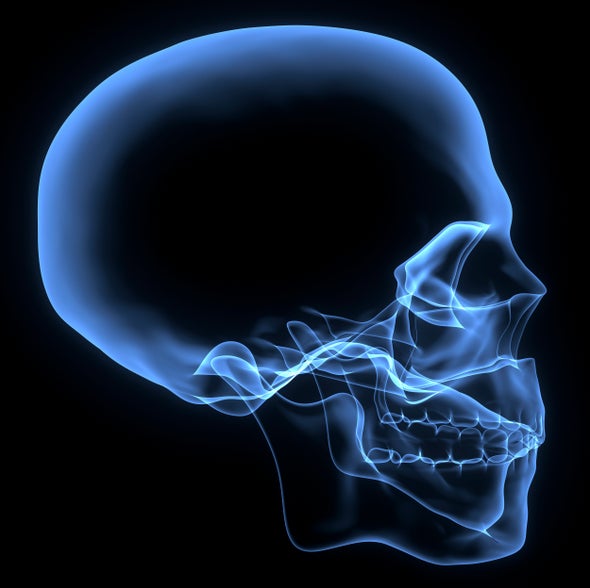(单词翻译:单击)
听力文本
This is Scientific American's 60-second Science, I'm Christopher Intagliata.
Certain concert venues, like Boston's Symphony Hall, are known to beautifully reflect the sounds of an orchestra. It turns out there's a similar process at play in your cochlea, deep inside your ear—where a tiny bony cavity houses the organ that allows you to hear.
"It's like its own tiny little acoustics chamber, if you will. So anything and everything you hear is going into our ear and then going into this little bony chamber."
Mike Gordon, a psychologist at William Paterson University in New Jersey. But while studying this process, he also found there's actually a lot of variability in the way people hear. Some frequencies can appear tens of decibels louder or quieter than average—based on the resonant properties of a person's skull.
"We were shocked. My first version of the draft had exclamation points all over the place, but we eventually removed those from the final copy."
First, Gordon's team gave 30 volunteers a hearing test—the standard type, where different frequencies of tones are played at varying loudness. Then they did a "bone conduction" hearing test, where vibrations are transmitted directly onto the skull, from behind the ear.
Finally, they projected white noise like this...
(CLIP: White noise sample)
... through the skull, from behind the ear, and recorded what came out at the forehead. This is that white noise...
(CLIP: White noise sample)
... filtered through Gordon's skull:
(CLIP: White noise sample 2)

With those filtered samples, they were able to see the unique spectral fingerprints each volunteer's skull left on the white noise, amplifying some frequencies and damping down others. And those ups and downs actually correlated to each volunteer's ability to perceive certain frequencies in the bone-conduction hearing test. Which means:
"The skull itself, because it's such an intimate and personal thing, is going to shape your experience of the world, perceptually."
The findings appear in the Journal of the Acoustical Society of America.
Although the research is just preliminary, Gordon says there might be some intriguing therapeutic uses of this new insight. "What if we could cheaply and easily run broadband noise through someone's skull and look at how it filtered—and then do it again later. Would it show us an injury? Well, it might if the skull changed dramatically, which could indicate a head injury."
And, more trivially, he says, perhaps it could explain why you really can't stand that one singer everyone else loves. Just blame it on the resonant properties of your skull.
Thanks for listening for Scientific American's 60-second Science. I'm Christopher Intagliata.
参考译文
这里是科学美国人——60秒科学系列,我是克里斯托弗·因塔格里塔。
波士顿交响音乐厅等音乐会场地,以能完美地反射管弦乐队的声音而闻名。结果表明,你耳朵深处的耳蜗中也发生着类似的过程,那里有微型骨腔,容纳着让我们听到声音的器官。
“如果你愿意这样说的话,它就像自已的小型声乐室。你听到的任何声音都会进入耳内,然后进入这个小骨室。”
新泽西州威廉·帕特森大学的心理学家迈克·戈登说到。但在研究这一过程的同时,他还发现,人们的听觉方式实际上有很多变化。根据个人头骨的共振特性,有些频率会比平均值高或低数十分贝。
“我们非常震惊。我的初稿到处都是感叹号,但我们的终稿最终删除了这些感叹号。”
首先,戈登的研究团队让30名志愿者进行了一项听力测试——这是一种标准的听力测试,以不同音量播放不同频率的音调。然后,他们做了一个“骨传导”听力测试,振动直接从耳朵后面传到头骨上。
最后,他们像这样播放白噪音,
(音频剪辑:白噪音样本)
让声音从耳朵后面通过头骨,并记录下从前额传出的声音。这就是白噪音……
(音频剪辑:白噪音样本)
通过戈登头骨后的声音
(音频剪辑:白噪音样本2)
通过这些过滤后的样本,他们能够看到每名志愿者留在白噪音上的头内独特光谱指纹,有些频率放大了,另外一些频率则减弱了。这些起伏实际上与每名志愿者在骨传导听力测试中感知特定频率的能力有关。意思是:
“因为头骨本身是如此亲密和个人的东西,它将在感知上塑造你对世界的体验。”
研究结果发表在《美国声学协会期刊》上。
戈登说,虽然这只是初步研究,但这一新发现可能产生某些有趣的治疗用途。“如果我们可以廉价且轻松地让宽带噪音通过某人的头骨并观察其过滤方式,然后再重复一次。这是否会显示出受伤之处?如果头骨发生巨大变化,这可能意味着头部受伤了。”
他说,更具体来说,这或许可以解释为何你真的无法忍受一个所有人都喜欢的歌手。这只能怪你头骨的共振特性。
谢谢大家收听科学美国人——60秒科学。我是克里斯托弗·因塔利亚塔。
译文为可可英语翻译,未经授权请勿转载!
重点讲解
重点讲解:
1. at play 发挥作用;
But there are also psychological factors at play.
但也有心理因素在起作用。
2. damp down 抑制,平息(强烈的感情、争吵或危机);
The entire spending boost could go on wage demands unless expectations are damped down.
除非降低预期,否则整个支出增长计划可能会导致加薪要求。
3. ups and downs 兴衰;浮沉;起落;悲欢;
We are bound to see some ups and downs along the road to recovery.
在经济复苏的过程中,我们一定会经历一些曲折起伏。
4. correlate to 相互关联;
Assessing whether different biological populations have gene expression profiles that correlate to their biogeographical distribution.
探索不同生物种群的基因表达谱是否与生物地理分布相关联。


